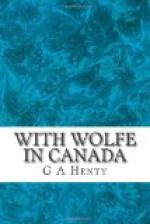“It’s just habit, my lad,” Nat said encouragingly to him; “there’s just as much difference between one side of the tree and the other, as there is between two men’s faces. It comes of practice. Now, just look at the roots of this tree; don’t you see, on one side they run pretty nigh straight out from the trunk, while from the other they go down deep into the ground. That speaks for itself. The tree has thrown out its roots, to claw into the ground and get a hold, on the side from which the wind comes; while, on the other side, having no such occasion, it has dipped its root down to look for moisture and food.”
“Yes, I do see that,” James said, “that is easy enough to make out; but the next tree, and the next, and, as far as I see, all the others, don’t seem to have any difference in their roots one side or the other.”
“That is so,” the scout replied. “You see, those are younger trees than this, and it is like enough they did not grow under the same circumstances. When a few trees fall, or a small clearing is made by a gale, the young trees that grow up are well sheltered from the wind by the forest, and don’t want to throw out roots to hold them up; but when a great clearing has been made, by a fire or other causes, the trees, as they grow up together, have no shelter, and must stretch out their roots to steady them.
“Sometimes, you will find all the trees, for a long distance, with their roots like this; sometimes only one tree among a number. Perhaps, when they started, that tree had more room, or a deeper soil, and grew faster than the rest, and got his head above them, so he felt the wind more, and had to throw out his roots to steady himself; while the others, all growing the same height, did not need to do so.”
“Thank you,” James said. “I understand now, and will bear it in mind. It is very interesting, and I should like, above all things, to be able to read the signs of the woods as you do.”
“It will come, lad. It’s a sort of second nature. These things are gifts. The redskin thinks it just as wonderful that the white man should be able to take up a piece of paper covered with black marks, and to read off sense out of them, as you do that he should be able to read every mark and sign of the wood. He can see, as plain as if the man was still standing on it, the mark of a footprint, and can tell you if it was made by a warrior or a squaw, and how long they have passed by, and whether they were walking fast or slow; while the ordinary white man might go down on his hands and knees, and stare at the ground, and wouldn’t be able to see the slightest sign or mark. For a white man, my eyes are good, but they are not a patch on a redskin’s. I have lived among the woods since I was a boy; but even now, a redskin lad can pick up a trail and follow it when, look as I will, I can’t see as a blade of grass has been bruised. No; these things is partly natur and partly practice. Practice will do a lot for a white man; but it won’t take him up to redskin natur.”




